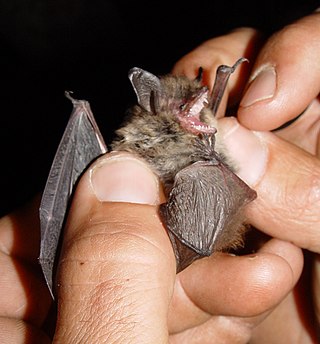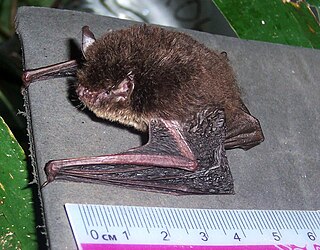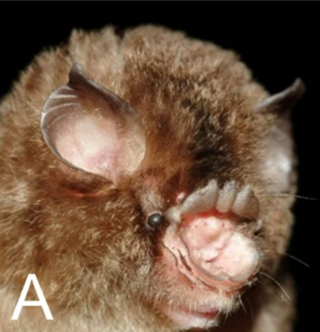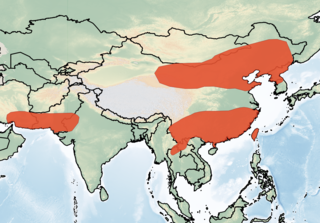
The mouse-eared bats or myotises are a diverse and widespread genus (Myotis) of bats within the family Vespertilionidae. The noun "myotis" itself is a Neo-Latin construction, from the Greek "muós and "oûs", literally translating to "mouse-eared".

Hodgson's bat, also called the copper-winged bat or black-and-orange myotis, is a species of vesper bat in the genus Myotis, the mouse-eared bats. Favouring mountain forests, it is found throughout Central, Southeast, and East Asia, from Afghanistan to Taiwan. It is about 5 centimetres (2.0 in) long and is distinguished from most other species of bat in this range by its yellowish colouration.

Blanford's bat, also known as the least false-serotine bat, is a species of vesper bat. It can be found in Brunei, Cambodia, Indonesia, Laos, Malaysia, Myanmar and Thailand, where it lives in various different forested habitats. The International Union for Conservation of Nature has assessed its conservation status as being of "least concern".

Cadorna's pipistrelle is a species of vesper bat in the family Vespertilionidae. It is found in India, Laos, Myanmar, Thailand, and Vietnam.

Hardwicke's woolly bat is a species of vesper bat in the family Vespertilionidae.

The hairy-faced bat is a species of vesper bat.

The wall-roosting mouse-eared bat, or Nepalese whiskered myotis is a species of vesper bat whose type locality is Nepal.

The Himalayan whiskered bat is a species of vesper bat. It is found in Bangladesh, Bhutan, Cambodia, China, India, Indonesia, Laos, Malaysia, Nepal, and Vietnam.

Stoliczka's trident bat is a species of bat in the family Hipposideridae. It is found in China, Laos, Malaysia, Myanmar, Thailand, and Vietnam.

The long-toothed pipistrelle is a species of bat of the genus Hypsugo. It is a small bat, with a length of 35.2–38.4 mm of forearm, and 5.9–7 mm of foot. It feeds on insects and has especially long canines compared to others of its genus.

Myotis indochinensis, commonly known as the Indochinese mouse-eared bat, is a species of cave-dwelling bat in the family Vespertilionidae. It is found in Vietnam and China.

Glischropus bucephalus, the Indochinese thick-thumbed bat, is a species of bat in the family Vespertilionidae. The bat is found in Cambodia, Myanmar, Laos, Thailand and Vietnam north of the Isthmus of Kra.

The Oriental serotine is a species of bat in the family Vespertilionidae. It is widespread and found throughout Asia.

The long-toed myotis or Taiwan long-toed myotis is a species of vesper bat endemic to Taiwan.

The orange-fingered myotis or red-painted myotis is a species of vesper bat endemic to the Philippines.

The reddish-black myotis or black-winged myotis, colloquially known as the "red bat" or "golden bat" in South Korea, is a species of vesper bat found throughout East Asia.
Weber's myotis is a species of vesper bat endemic to the Indonesian island of Sulawesi.

Peyton's myotis, also known as Peyton's whiskered bat, is a species of vesper bat endemic to India.

The Malaysian whiskered myotis or Malayan whiskered myotis is a species of vesper bat endemic to Malaysia, although it may possibly also occur in Indonesia.

The Bornean whiskered myotis is a species of vesper bat endemic to Borneo.



















